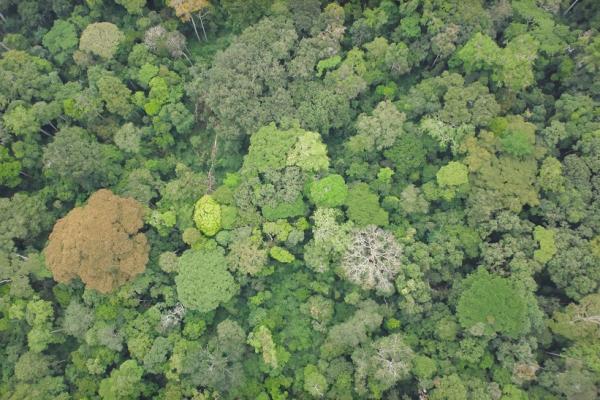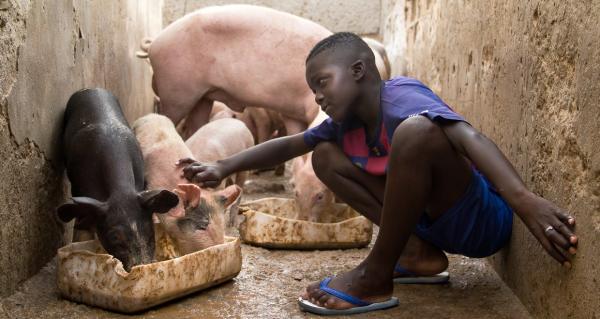The tropical forests of the Congo Basin, the Amazon and Southeast Asia are the world's second largest carbon sink and home to almost 80% of its terrestrial biodiversity. They are therefore vital for the economy and for human survival. However, there is a major risk that the benefits they provide may disappear, in view of the degradation they have suffered in recent years and continue to suffer. We therefore urgently need to preserve what remains and manage it sustainably.
The fundamental role of field data
To this end, it is crucial to understand how these forest ecosystems function. Data are the building blocks of knowledge, and particularly of decision making. Those data are obtained in two main ways: satellites and remote sensing on the one hand, and field observations on the other. Satellite images provide general, quick information that serves to model the structure and dynamics of forests. However, those images require confirmation from field data gathered through forest inventories, in order to calibrate those models and provide a picture of the biological, ecosystemic and socioeconomic state and evolution of those forests. In particular, data gathered in situ better represents the range of forest sub-types, model their respective dynamics and combine those dynamics with remote sensing monitoring, to extrapolate the results to entire forest basins.
For instance, "In central Africa, ten main types of forest have been identified"*, says Pascal Bonnet, Deputy Director of CIRAD's Environments and Societies department. "We currently only have reliable data for around half of them. So we need to extend that knowledge to every type of forest, and for example to include data from sites in the Democratic Republic of the Congo, the largest forested country in the Congo Basin."
Those data cover various aspects: flora and fauna biodiversity, biomass and carbon stocks, socioeconomic activities, etc. They serve to measure evolutions over time, model behaviour and make predictions. As such, they may potentially form the basis for an analysis to support public policy decisions in response to social and ecological issues and provide people and industry with sustainable solutions. In particular, they serve to improve forest concession management plans and logging regulations, to guarantee the sustainability of the ecosystem services forests provide.
Trust-based partnerships to gather and aggregate data
To achieve this, trust-based partnerships, to build scientific networks and public-private partnerships, are vital. They involve a wide range of stakeholders in the information chain, from initial measurements to the use of analysis results by decision-makers and a wider audience. The resulting networks oversee experimental stations on the ground and data platforms, and help supply key information obtained through forestry research.
Some sites, such as Paracou in French Guiana or Mbaïki in the Central African Republic, are known as reference "supersites" and emblematic long-term research bases. They have been operational for around forty years, and generate large volumes of quality data that provide answers to a multitude of questions about the major tropical forests they cover: logged forest dynamics, their reconstitution, as yet unlogged forest performance, the impact of logging on biodiversity, carbon stocks and fluxes, and that of climate change on tree stands. However, despite their importance, the future of these sites is under threat because of their irregular funding, primarily from projects.
DynAfFor, funded by the Fonds français pour l’environnement mondial, is one of those projects. Mbaïki is one of its main reference sites, where since 1982, measurements have been taken of tree growth, the evolution of species communities, and, every fortnight, the phenology of certain species, etc. DynAfFor covers ten sites in central Africa, and has enabled recommendations for making logging regulations more sustainable, by integrating new knowledge of the ecology of the species being logged and the variability of environmental conditions.
The goal of this project, implemented at ten sites in Central Africa, is to define rules for sustainable logging that integrate the ecological functioning of tree populations and stands and the variability of environmental conditions.
The Paracou station, for its part, stretches across 125 hectares in French Guiana. It has been operational since 1984, and is devoted to the study of climate change and its impact on the Amazon Forest. It has enabled mapping of 70 000 trees, which are measured regularly. Paracou also contributes to a number of scientific networks. For instance, the Guyafor network, which federates observation sites in French Guiana, is both an observatory and a tool for the long-term surveillance of the forests in French Guiana.
These sites have served to strengthen various thematic networks, through various projects and partnerships. They include the Tropical managed Forests Observatory (TmFO) and more specifically, in central Africa, the Dynafac collective, the DynAfFor project and the P3FAC project, a public-private alliance.
Platforms in partnership for research and training such as the Research network on the forests of central Africa (R2FAC) or the Forests, agriculture and territories in the Amazon platform (Amazonie) act as platforms for exchanges and scientific emulation, contributing to effective governance of these data gathering and use systems, which are vital for understanding how forest territories evolve.
"Forests have a slow, complex dynamic", stresses CIRAD's Vivien Rossi, a biostatistics expert. "It must be observed over a long period if it is to be understood. In central Africa, we began setting up monitoring structures with our partners over 40 years ago. We recently formalized these historic partnerships between scientific institutions through the R2FAC network, to boost the impact of our work and support junior researchers from the region."
How can we improve polices, strategies and modes of intervention on every level so as to ensure the long-term preservation of the Congo Basin forests and food security for the people who derive a living from them?
Having a range of sources of data is also a guarantee of long-term forest monitoring. In addition to structures operated by research organizations, essential field data may come from forestry concessions that have a bond of trust with research – CIRAD is one beneficiary – and from specific scientific projects.
The need to involve village communities
However, this is not enough to cover every component of the biodiversity of forest territories, particularly as regards the fauna and sustainable management of territories belonging to village communities. In Gabon, to obtain rights over the fauna in their territories, communities have agreed to set up community forests. This means they have to conduct an inventory of resources and produce a simple management plan. To help them do so, CIRAD has worked with the Ministry of Water and Forests as part of the Sustainable Wildlife Management (SWM) programme, to build collaborative and participatory information systems to support decision making. Those systems serve to compile data on the number of animals hunted and wildlife species counts. They are based on images obtained from camera traps that use artificial intelligence. The communities concerned use those data to adjust the number of animals they hunt.
Citizens should also be involved, through what is known as participatory science, of which the Pl@ntNet app is the perfect example.
The Pl@ntNet app, initiated almost ten years ago by researchers from four organizations (CIRAD, INRAE, INRIA and IRD), can be used to identify a plant by taking a photograph of part of it. Some 29 000 species are now listed in this scientific tool, which has been downloaded more than 16 million times worldwide.
Long-term data gathering is vital
Gathering field data is therefore vital. This was demonstrated by an international study, based on an exceptional dataset from an inventory of more than 6 million trees in five countries. The study revealed the composition of central Africa's tropical forests and their vulnerability to the probable increased climate and human pressure in coming decades.
An international study coordinated by researchers from IRD and CIRAD reveals the composition of the tropical forests of Central Africa and their vulnerability to the increased pressure from climate change and human activity expected in the coming decades. Thanks to an exceptional dataset - an inventory of over 6 million trees across five countries - the researchers have produced the first continuous maps of the floristic and functional composition of these forests, allowing them to identify the most vulnerable areas. The results were published in Nature on 21 April 2021.
Sustaining these sites and the associated research activities is a constant challenge. The fact that the ecological dynamics of forest ecosystems cover the very long term makes this even more important.
Hence the importance of building long-term, trust-based partnerships with all the stakeholders in forests and training generations of experts to monitor and analyse the evolution of those forests
CIRAD Dataverse
CIRAD Dataverse allows the establishment's researchers to store, disseminate and use the research data they generate or co-generate with their partners in the global North and global South.
For instance, the SWM Gabon project's "hunting" dataset is available on CIRAD Dataverse. There is no other such database on the current data market.
One Forest Summit & One Forest Vision
The One Forest Summit, initiated by the President of the Gabonese Republic Ali Bongo Ondimba and the President of the French Republic Emmanuel Macron at COP27 (climate) in Sharm El Sheikh in November 2022, was held in Libreville, Gabon, on 1 and 2 March this year. The summit fits into the series of One Planet Summits organized by France since 2017 and devoted to global issues. The One Forest Vision resulted from the summit. It includes a plan to map the tropical rainforests of the main three global forest basins – the Congo, the Amazon and Southeast Asia –, with a view to preserving them more effectively.
* Rejou-Mechain M., Mortier F., Bastin J.-F., Cornu G., Barbier N., Bayol N., Bénédet F., Bry X., Dauby G., Deblauwe V., Doucet J.-L., Doumenge C., Fayolle A., Garcia C., Kibambe Lubamba J.-P., Loumeto J.J., Ngomanda A., Ploton P., Sonké B., Trottier C., Vimal R., Yongo O.D., Pélissier R., Gourlet-Fleury S., 2021. Unveiling African rainforest composition and vulnerability to global change. Nature, 593, 90-94































